Museum of the Origins of Man
THE BICEPHALIC HUMAN HEAD IN POST-PALEOLITHIC SCULPTURE
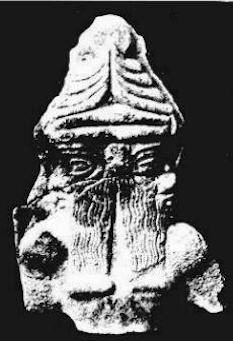
Fig. 5A1) Bicephalic anthropomorphic stone sculpture representing a bicephalic deity such as Janus, El-Kronos, Argo, Borea, etc. The headdress is very beautiful, as in all the sculptures of evolved civilizations.
Origin: Babylon
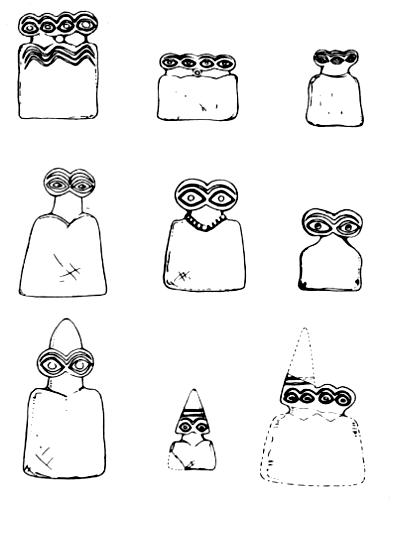 Fig. 5A2) Anthropomorphic stone sculptures. These are little idols in alabaster or stone. According to scholars of ancient religions, they are related to the celestial or solar character of the deity worshipped in the temple, and may have votive significance. These multiple-eyed idols harbor traditions of various deities. The multiple eyes, like the multiple arms in the same sculpture, fall within the category of "bicephalic (two-headed)". There are four types: male; female; male and female couple with a single mouth; and the little idol with three eyes. Of interest are the hats, similar to the first hats known in Paleolithic sculpture.
Fig. 5A2) Anthropomorphic stone sculptures. These are little idols in alabaster or stone. According to scholars of ancient religions, they are related to the celestial or solar character of the deity worshipped in the temple, and may have votive significance. These multiple-eyed idols harbor traditions of various deities. The multiple eyes, like the multiple arms in the same sculpture, fall within the category of "bicephalic (two-headed)". There are four types: male; female; male and female couple with a single mouth; and the little idol with three eyes. Of interest are the hats, similar to the first hats known in Paleolithic sculpture.
Dimensions: they average 2 inches in height.
Origin: Temple of Brak, Tell Brak, Valley of Khabur, northern Syria. Dating: fourth millennium BC.
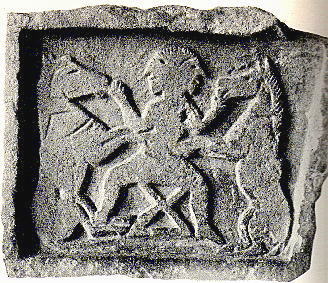 Fig. 5A3) Stone sculpture in bas-relief representing a man with a bicephalic head, sitting between two rearing horses. It is called "God, the ruler of animals". Two animals at the sides of the god are a new recurring theme in the iconographies of the first urban civilizations.
Fig. 5A3) Stone sculpture in bas-relief representing a man with a bicephalic head, sitting between two rearing horses. It is called "God, the ruler of animals". Two animals at the sides of the god are a new recurring theme in the iconographies of the first urban civilizations.
Dimensions: Height: 11.8 inches; Width: 14.9 inches; Maximum thickness: 6.6 inches.
Origin: Villaricos, Spain.
Location: Archaeological Museum of Barcelona, Spain.
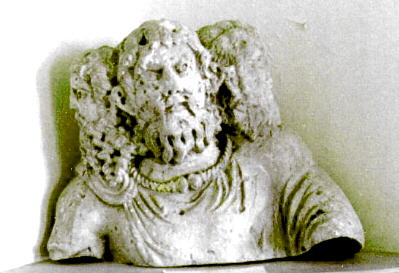 Fig. 5A4) Bicephalic anthropomorphic marble sculpture representing a bust of a man with three bearded heads. It depicts the Gallic god with three heads. The style and workmanship are attributable to classical Greece. Its name is unknown, as no inscriptions have been found.
Fig. 5A4) Bicephalic anthropomorphic marble sculpture representing a bust of a man with three bearded heads. It depicts the Gallic god with three heads. The style and workmanship are attributable to classical Greece. Its name is unknown, as no inscriptions have been found.
Height: 17.7 inches approx.
Origin: Condat, Dordogne, France.
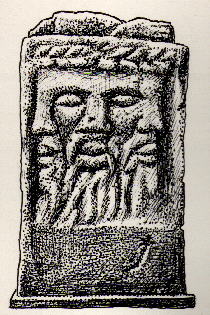 Fig. 5A5) Anthropomorphic stone sculpture (drawing) representing the head of a bearded man with three faces and two eyes.
Fig. 5A5) Anthropomorphic stone sculpture (drawing) representing the head of a bearded man with three faces and two eyes.
It represents the Gallic god with three faces.
Height: 20 inches approx.
Origin: Reims, France.
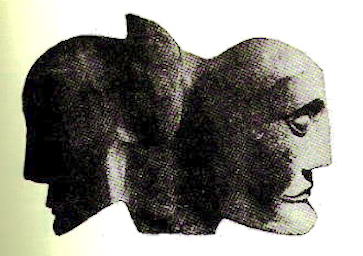 Fig. 5A6) Anthropomorphic stone bicephalic sculpture representing two beardless and hairless human heads, joined and looking in opposite directions; between the two heads is a smaller one without any facial details.
Fig. 5A6) Anthropomorphic stone bicephalic sculpture representing two beardless and hairless human heads, joined and looking in opposite directions; between the two heads is a smaller one without any facial details.
It represents a Celtic-Gallic god, tricephalic in origin, but for reasons of worship (as the scholars of this religion argue) one of the three heads has been obliterated, but traces of it remain in the reduced representation.
Height: 11.8 inches approx.
Origin: Roquepertuse, Mouths of the Rhone, France.
Location: Musée Lapidaire et Archéologie, Marseilles, France.
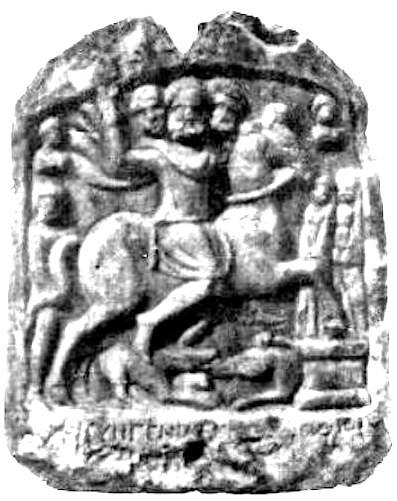 Fig. 5A7) Stone sculpture in bas-relief representing a riding man with three bearded heads; in the background are several human figures. It represents the horse riding god with three heads. In ancient Thrace, the god also had two heads. It is a solar god. Hundreds of these stelae have been found in Bulgaria.
Fig. 5A7) Stone sculpture in bas-relief representing a riding man with three bearded heads; in the background are several human figures. It represents the horse riding god with three heads. In ancient Thrace, the god also had two heads. It is a solar god. Hundreds of these stelae have been found in Bulgaria.
Dimensions: small size.
Origin: Plovdiv, Bulgaria.
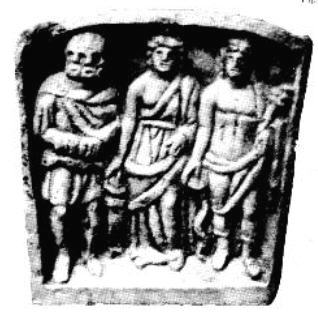 Fig. 5A8) Stone sculpture in bas-relief representing a man with a tricephalic head, with big lips, along with a woman and a man. It represents the tricephalic god and two deities. It represents the three-headed god and two divinities. The meaning of the big lips is unknown; however, although rare such depictions occur in the Paleolithic, the Mesolithic and in proto-history.
Fig. 5A8) Stone sculpture in bas-relief representing a man with a tricephalic head, with big lips, along with a woman and a man. It represents the tricephalic god and two deities. It represents the three-headed god and two divinities. The meaning of the big lips is unknown; however, although rare such depictions occur in the Paleolithic, the Mesolithic and in proto-history.
Dimensions: small size.
Origin: Dennevy, France.
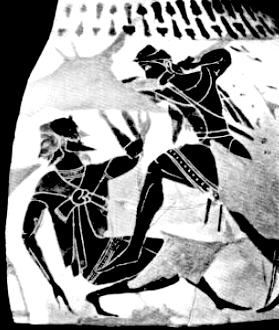 Fig. 5A9) Painted ceramic vase showing a fighting scene between a man and another man with a bicephalic head, representing Argo, the god generally depicted with its body strewn with eyes. Usually, this god has one bearded face and the other is beardless.
Fig. 5A9) Painted ceramic vase showing a fighting scene between a man and another man with a bicephalic head, representing Argo, the god generally depicted with its body strewn with eyes. Usually, this god has one bearded face and the other is beardless.
Origin: Greece.
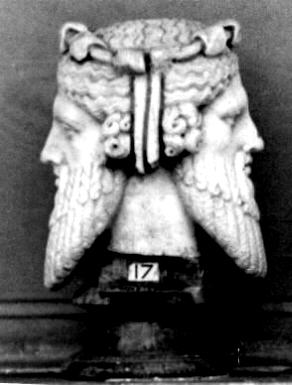 Fig. 5A10) Bicephalic anthropomorphic marble sculpture. It represents the bicephalic Janus. This god has been portrayed in many ways: bearded, beardless, with one bearded face and one beardless, with two elders, with two young men, with one elder face and the other young one, and with a remarkable variety of types of hairstyles. hair and beard.
Fig. 5A10) Bicephalic anthropomorphic marble sculpture. It represents the bicephalic Janus. This god has been portrayed in many ways: bearded, beardless, with one bearded face and one beardless, with two elders, with two young men, with one elder face and the other young one, and with a remarkable variety of types of hairstyles. hair and beard.
Dimensions: about natural.
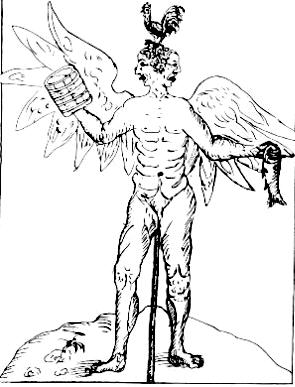 Fig. 5A11) A print published in the 17th century representing a man with bicephalic head, wings and a rooster on his head. One of his hand holds an undefined object, while the other supports a fish.
Fig. 5A11) A print published in the 17th century representing a man with bicephalic head, wings and a rooster on his head. One of his hand holds an undefined object, while the other supports a fish.
It represents Wejopatis, the Prussian god of wind.
For more than a century America had been colonized; the press was widespread in Europe, but Christianity had not yet conquered all of Europe, and in some areas such as Prussia a bicephalic god was still worshipped. This is further testimony of how deeply religions are rooted in peoples.
According to the typology of the Paleolithic sculptures, this god, having wings, can be considered a human-animal hybrid.
Origin: Prussia, Germany.
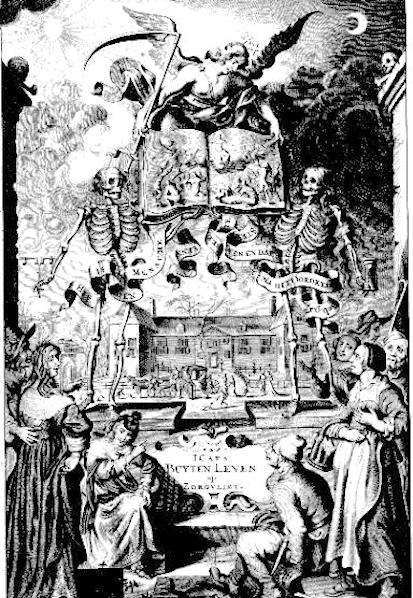
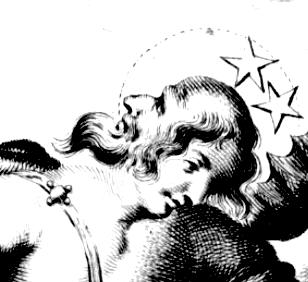 Fig. 5A12) Bicephalic angel holding a book with Christian subjects (print). The sun, moon and other symbolic images are depicted. The angel has the appearance of a woman and therefore is beardless, while the matched head on the neck is bearded. One of the wings towards the sun is of a bird, while the one towards the moon is of a bat.
Fig. 5A12) Bicephalic angel holding a book with Christian subjects (print). The sun, moon and other symbolic images are depicted. The angel has the appearance of a woman and therefore is beardless, while the matched head on the neck is bearded. One of the wings towards the sun is of a bird, while the one towards the moon is of a bat.
It was possible to depict all this religious symbolism using the technical means that drawing on paper allows; it's impossible in all-round stone sculpture; but this complex world of symbols has always been present in religion, in spoken form, and still is today.
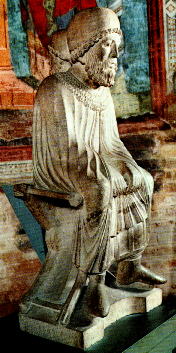 Fig. 5A13) Bicephalic anthropomorphic stone sculpture representing a seated man with two heads joined at the neck, looking in opposite directions. It represents the bicephalic god January (or Janus); it is associated with eleven other statues, each representing a month of the year.
Fig. 5A13) Bicephalic anthropomorphic stone sculpture representing a seated man with two heads joined at the neck, looking in opposite directions. It represents the bicephalic god January (or Janus); it is associated with eleven other statues, each representing a month of the year.
Dating: 13th century AD.
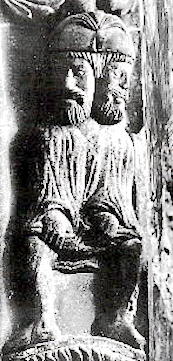 Fig. 5A14) Bicephalic anthropomorphic stone sculpture representing a seated man with two forward-looking heads. It represents the "bicephalic January warming itself by the fire", and in fact at his feet flames are depicted.This sculpture is placed outside the Cathedral of Parma, and leaning against the wall, it probably has two heads in parallel, unlike the other bicephalic January (Janus)(Fig. 5A13) which is inside the Cathedral, and which has two heads joined at the neck and looking in opposite directions.
Fig. 5A14) Bicephalic anthropomorphic stone sculpture representing a seated man with two forward-looking heads. It represents the "bicephalic January warming itself by the fire", and in fact at his feet flames are depicted.This sculpture is placed outside the Cathedral of Parma, and leaning against the wall, it probably has two heads in parallel, unlike the other bicephalic January (Janus)(Fig. 5A13) which is inside the Cathedral, and which has two heads joined at the neck and looking in opposite directions.
The presence in a Christian Cathedral of bicephalic sculptures of Janus (one inside and one outside) shows that this deity, even if it was not in the Christian pantheon, was still present in the beliefs of the people, otherwise the priests would not have put them.
Location: Cathedral of Parma, Parma, Italy.
Dating: 13th century A.D.
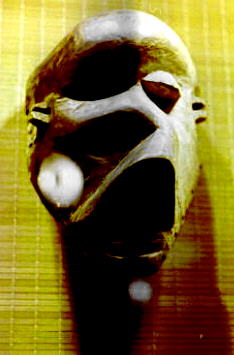 Fig. 5A15) Bicephalic anthropomorphic wooden sculpture representing half a human head of a living person, and half a human head of a deceased one, who looks almost like a skull. The mouth is wide open and we don't know its meaning.
Fig. 5A15) Bicephalic anthropomorphic wooden sculpture representing half a human head of a living person, and half a human head of a deceased one, who looks almost like a skull. The mouth is wide open and we don't know its meaning.
Height: 11.8 inches.
Origin: Central Africa.
Location: Museum Royal of Central Africa, Tervuren, Belgium.
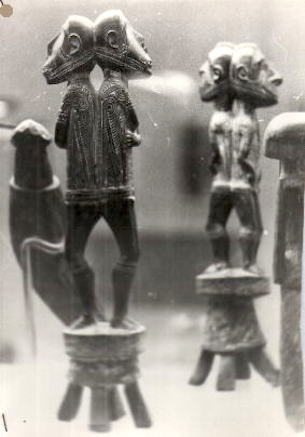 Fig. 5A16) Bicephalic anthropomorphic wooden sculptures. This is one of the many versions of bicephaly, in which, instead of being a body and two heads, there are two heads joined at the neck, and two bodies joined at the back. These two sculptures probably come from places far from each other, as they represent two different varieties of Homo sapiens sapiens; one of short stature and one of tall stature. Even the styles are different: the short men are depicted with a realistic, almost caricatural style, while the tall men are depicted in an elegant style, which tends to lengthen the head, reduce some details of the face, and abolish the eyes; their bodies are also decorated with engravings. The two sculptures are from the same religion.
Fig. 5A16) Bicephalic anthropomorphic wooden sculptures. This is one of the many versions of bicephaly, in which, instead of being a body and two heads, there are two heads joined at the neck, and two bodies joined at the back. These two sculptures probably come from places far from each other, as they represent two different varieties of Homo sapiens sapiens; one of short stature and one of tall stature. Even the styles are different: the short men are depicted with a realistic, almost caricatural style, while the tall men are depicted in an elegant style, which tends to lengthen the head, reduce some details of the face, and abolish the eyes; their bodies are also decorated with engravings. The two sculptures are from the same religion.
In the photograph there is also a wooden sculpture which depicts a phallus, which was an object of worship.
Height: about 51.2 inches including the stool.
Origin: Central Africa.
Location: Royal Museum of Central Africa, Tervuren, Belgium.
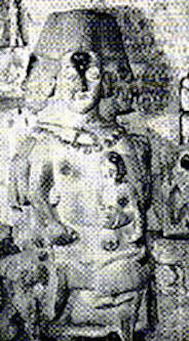 Fig. 5A17) Bicephalic anthropomorphic stone sculpture representing Triloknath, a deity currently worshipped.
Fig. 5A17) Bicephalic anthropomorphic stone sculpture representing Triloknath, a deity currently worshipped.
Location: Triloknath Temple, Mandi, India.
Dating: 16th century AD.
 Fig. 5A18) Bicephalic anthropomorphic stone sculpture representing the god Agni with two heads. It symbolizes "domestic and sacrificial fire".
Fig. 5A18) Bicephalic anthropomorphic stone sculpture representing the god Agni with two heads. It symbolizes "domestic and sacrificial fire".
Origin: India.
Dating: 2nd century BC.
Location: Guimet Museum of Asian Art, Paris.
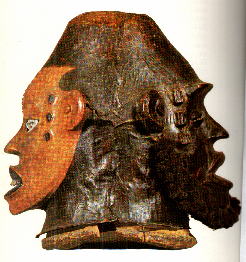 Fig. 5A19) Bicephalic anthropomorphic wooden sculpture. It is a dance mask for cult rituals.
Fig. 5A19) Bicephalic anthropomorphic wooden sculpture. It is a dance mask for cult rituals.
Origin: Ekoi, Cross River region, Nigeria.
Location: British Museum, London.
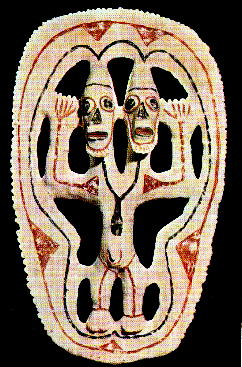 Fig. 5A20) Bicephalic anthropomorphic limestone sculpture representing a man with two heads, representing an "ancestorâ". This is a local aspect of transformation of the religion from one cult to another, maintaining the typology of the representation, that is the anthropomorphic idol with two heads. However, it is not excluded that in the Paleolithic there was an ancestor cult connected to similar representations.
Fig. 5A20) Bicephalic anthropomorphic limestone sculpture representing a man with two heads, representing an "ancestorâ". This is a local aspect of transformation of the religion from one cult to another, maintaining the typology of the representation, that is the anthropomorphic idol with two heads. However, it is not excluded that in the Paleolithic there was an ancestor cult connected to similar representations.
Origin: New Ireland, Papua New Guinea.
Location: Museum für Volkerkunde (Hamburg Museum of Ethnology), Hamburg, Germany.
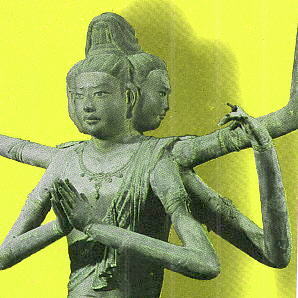 Fig. 5A21) Bicephalic anthropomorphic sculpture (detail) representing a human figure with three heads and six arms.
Fig. 5A21) Bicephalic anthropomorphic sculpture (detail) representing a human figure with three heads and six arms.
It represents Ashura, a minor deity, one of the eight guardians of Buddha.
Origin: Nara, Japan.
Dating: 734 AD.
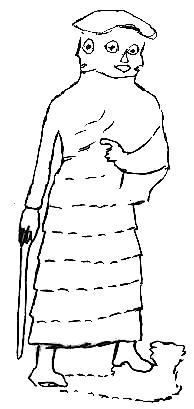 Fig. 5A22) Bicephalic anthropomorphic bronze sculpture (drawing) representing a man with a head with four faces.He is a male deity.
Fig. 5A22) Bicephalic anthropomorphic bronze sculpture (drawing) representing a man with a head with four faces.He is a male deity.
Height: 6.8 inches.
Origin: Iraq.
Dating: 1,800-1,700 BC.
Location: Oriental Institute, University of Chicago (USA).
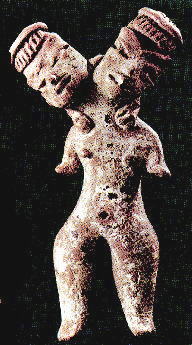 Fig. 5A23) Bicephalic anthropomorphic ceramic sculpture representing a naked woman with two heads. It represents a divinity connected to the cult of fertility. This sculpture is represented again (Fig. 8A9) in the section on "Venuses" and Mother Goddesses.
Fig. 5A23) Bicephalic anthropomorphic ceramic sculpture representing a naked woman with two heads. It represents a divinity connected to the cult of fertility. This sculpture is represented again (Fig. 8A9) in the section on "Venuses" and Mother Goddesses.
A remarkable quantity of this type of sculpture has been found, constituted from various other types of heads, that is: a head with two faces; two heads assembled in one single head looking forward, and various types of hairstyles or headdresses, some of which are published on this site.
Dimensions: eight from 2.3 to 5.1 inches, with an average of 3.9 inches.
Origin: Tlatilco, Mexico.
Dating: 1,100-500 BC.
NEXT
Index
HOME PAGE
Page translated from Italian into English by Paris Alexander Walker.
Copyright©2020 by Museum of the Origins of Man, all rights reserved. 























